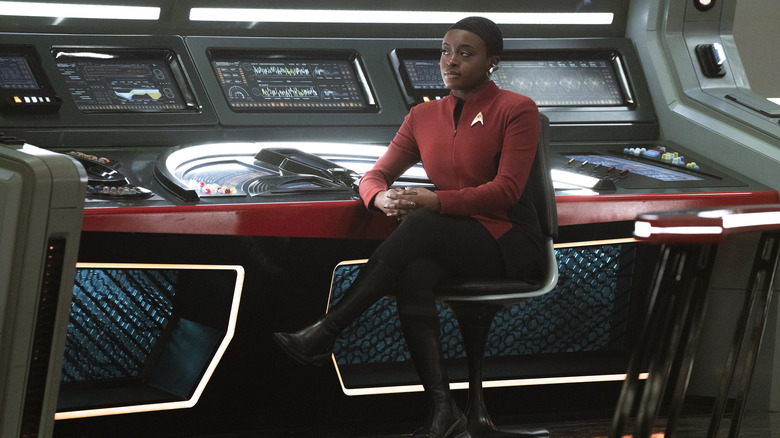Star Trek: Strange New Worlds Has A Secret Sauce When It Comes To Picking Directors
"Star Trek" has long thrived on genre diversity. While overall a sci-fi workplace drama, "Star Trek" has always free rein to delve into horror, comedy, action, political intrigue, and, most importantly, its own unique type of speculative morality play. The shows may film on reused sets, but there are subtle uses of camera, of lighting, and of color that should — ideally — make each individual episode stand out. This is especially true in the Paramount+ era, which makes extensive use of a high-tech, programmable backdrop called an AR wall. Colors and moods can now be more subtly altered from show to show, and from episode to episode.
Most recently, director Dermott Downs directed a musical episode of "Star Trek: Strange New Worlds" called "Subspace Rhapsody." That episode saw the Enterprise crew psychically affected by a strange spatial phenomenon that forced them to behave, in fits, like they were characters in a stage musical. Naturally, the temptation to direct the episode in a very stylized way was succumbed to, and Downs filmed the musical numbers with a lot of mood, quick editing, and music video dynamics.
In a recent episode of the "Star Trek" interview show "The Ready Room," "Trek" actor and directing veteran Jonathan Frakes spoke about the textures of "Strange New Worlds" and the subtle inter-episode lighting differences therein. Each episode has its own color and tone, he said. Frakes also mentioned he was selected early on, and that Paramount's selection of him as director for the crossover episode "Those Old Scientists" was due to a certain genre je ne sais quoi.
The prolific Jonathan Frakes
Frakes has directed 30 episodes of various "Star Trek" shows in his career, counting a few episodes of the "Trek"-adjacent series "The Orville." He had also played the character of William Riker on both "Star Trek: Picard" and "Star Trek: Lower Decks," so he was very familiar with what each individual show was all about. When he heard that he had been selected to direct a comedic episode, he couldn't have been more thrilled. Frakes noted that the "Strange New Worlds" showrunners Henry Alonzo Meyers and Akiva Goldsman have dictated that every episode should be "its own movie."
"Each episode will be its own movie, its own color, its own tone," he said. He reiterated later:
"When you're hired as a director on 'Strange New Worlds,' you're told that you're going to do your episode as a movie. And your movie will be a horror movie, or an action movie, or a period movie, or in this case, it's a full-on comedy. Which was a thrill for me, I quickly realized."
It seems that handling each individual episode is just that: Handling an individual episode. While there may be a "house style," each individual director knows that they'll be operating on their own terms within the rules of a genre, not a franchise. The genre diversity of "Star Trek" allows for a great deal of directorial creativity, and selecting a director seems to have more to do with a person's pliability than with their ability to take orders and follow studio notes (although I'm sure the latter certainly helps).
"Strange New Worlds" is about to wrap up its second season on Paramount+.

